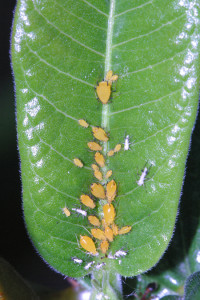
Neonicotinoids are especially effective against sap-feeding insects like aphids.
Neonicotinoids are a new class of insecticides chemically related to nicotine. The name literally means “new nicotine-like insecticides”. Like nicotine, the neonicotinoids act on certain kinds of receptors in the nerve synapse. They are much more toxic to invertebrates, like insects, than they are to mammals, birds and other higher organisms.
One thing that has made neonicotinoid insecticides popular in pest control is their water solubility, which allows them to be applied to soil and be taken up by plants. Soil insecticide applications reduce the risks for insecticide drift from the target site, and for at least some beneficial insects on plants.
There are several different kinds of neonicotinoid insecticides. The first neonicotinoid to reach the market was imidacloprid, a common ingredient in Bayer Advanced Garden insecticides. This product can be sprayed on the plant, but is often more effective (especially on sucking insects) when applied to the soil. Dinotefuran (Safari) is another, more highly water-soluble, neonicotinoid that is especially good on sap-feeding insects.
To find out whether an insecticide you see on the shelf of your hardware, pest control supply or garden center is a neonicotinoid, look on the list of active ingredients. If you see one of the following names listed, the insecticide includes a neonicotinoid:
- Acetamiprid
- Clothianidin
- Dinotefuran
- Imidacloprid
- Nitenpyram
- Thiocloprid
- Thiamethoxam
In addition to being effective against sap-feeding pests, neonicotinoids provide good control against certain beetles (like white grub larvae in lawns), fleas (Advantage flea control products, and nitenpyram pills for pets), certain wood boring pests, flies (fly baits), cockroaches and others.
Environmental concerns
Initially neonicotinoids were praised for their low-toxicity to many beneficial insects, including bees; however recently this claim has come into question. New research points to potential toxicity to bees and other beneficial insects through low level contamination of nectar and pollen with neonicotinoid insecticides used in agriculture. Although these low level exposures do not normally kill bees directly, they may impact some bees’ ability to foraging for nectar, learn and remember where flowers are located, and possibly impair their ability to find their way home to the nest or hive. Despite the controlled studies completed to date, the actual impact of neonicotinoid insecticides on honey bees in the field are difficult to measure. It is still not known whether these effects explain bee colony collapse disorder, or have had any effect in agriculture or, especially, in urban areas.
The relative infrequency with which bees are expected to encounter neonicotinoid insecticides in urban landscapes suggest that the impact of these insecticides in backyard gardens, when used appropriately, is probably minor. To keep risk to bees and other beneficials low, however, a few simple steps should be taken: (1) follow the label directions carefully, (2) restrict neonicotine applications to the soil, or during times when bees are not foraging (e.g., in the evening), and (3) treat only those individual plants which need treatment for a known pest infestation.